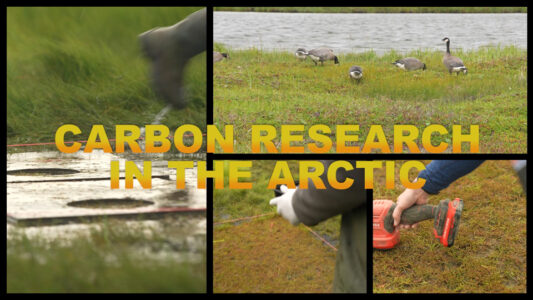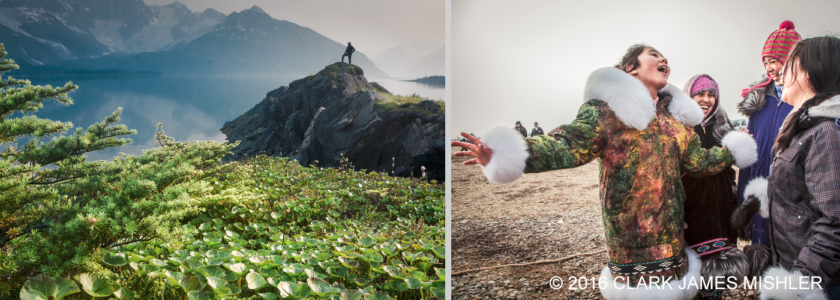
“The closer to the ocean, it seems like, the stronger the warming signal in the Arctic right now,” Vladimir Romanovsky told Frontier Scientists, and a warming Arctic leads to warming permafrost. Romanovsky, professor of Geophysics, heads the Permafrost Laboratory at the University of Alaska Fairbanks Geophysical Institute. Alaska is edged by oceans on three sides. Romanovsky believes diminishing sea ice conditions around Alaska impose strong impacts on Alaskan temperatures. “There is plenty of ocean with sea ice which is getting smaller and smaller and smaller in the summer, triggering this feedback of albedo, atmosphere, and temperature.”
“The temperature of permafrost is rapidly changing,” said Romanovsky. Permafrost is subsurface soil which has remained frozen for two years or more; some Arctic permafrost has been frozen for thousands of years. Now, permafrost temperatures in Alaska are rising unexpectedly swiftly. “The warming of permafrost is following warming in air temperatures,” Romanovsky stated.
Why it matters
Permafrost soils in high latitudes are estimated to store twice as much carbon as is currently contained in Earth’s atmosphere. As permafrost soil thaws, carbon stored inside it is freed to be released into the atmosphere as carbon dioxide (CO2) or methane gas (CH4), both of which contribute to global warming.
Scientists acquire information to build a more precise understanding of how large a quantity of greenhouse gasses will emerge from permafrost and what timeline those emissions will follow. They want to define permafrost particulars as well as the magnitude and timing of carbon emissions from permafrost to correctly calculate the potential feedback from permafrost carbon to climate change.
The status quo was once ‘slow’
Romanovsky noted “Somewhere 10 years ago we saw an increase in temperature, but we were kind of thinking, well, it is increasing fast now, but it will slow down.” General permafrost knowledge held “It is [a] very slow-changing environment and slow changing temperatures of permafrost.” Regarding permafrost temperature predictions 10 years ago, Romanovsky said “If anybody would ask me at that time, I would say ‘Yes, it will probably be stable until the end of the century. So we shouldn’t worry about it.'”
Subsequent thawing has forced his viewpoint to shift.
Accelerating rates
Romanovsky and colleagues continued taking measurements and keeping records of permafrost temperature change rates in Alaska. “We found that the rate actually was not slowing down, the rate was still pretty high, and now the rate was accelerating again.”
“If this warming will continue at the same pace as climate then permafrost will start to thaw before the end of the century on the North Slope. So that’s kind of a big surprise for us. And we will see what will happen,” as they continue to take the temperature of Alaska’s North Slope in the coming years.
By 2060
“If you simply project with the same rate for the future the surface of permafrost temperature will be very very close to 0 degrees Celcius– to the [melting] threshold– somewhere by 2060, which was not expected at all.” Romanovsky said “That will be very interesting to see.”
“We knew eventually it would happen,” he said. “The surprise here is that it could happen much sooner than we were thinking.”
Of course there is uncertainty in predicting permafrost temperature change. “It could slow down but it could get warmer faster. So we will see how it will go.” Romanovsky stated “It’s supposed to be getting colder, just looking at the previous changes in temperature. But it doesn’t do it. It’s still continuously getting warmer and warmer.”
Becoming a believer
Romanovsky: “In San Francisco about 5 years ago I said: ‘Well, if temperature will not behave [as] what I would expect according to natural cycles and it will not start to get a little bit cooler … then I will think about how much global warming we see. But if it will continue to warm, then that’s it, I’m a 100% believer in global warming.’ And that happened. Now I have to follow what I promised. But we will see, of course– it is very difficult to predict.”
Permafrost temperature measurements are collected annually at boreholes scattered across Alaska. Romanovsky: “Every year we have one more point on our curve and we’ll see how it goes, but so far it seems like it is going up and up and up.”
Projections
Supercomputer-driven simulations constructed with data gathered in the field help predict the future of permafrost. ‘GIPL 1.0 – Spatially Distributed Model of Permafrost Dynamics in Alaska’ is a simulation or model built by the Geophysical Institute Permafrost Laboratory (GIPL) at University of Alaska Fairbanks used to predict permafrost conditions under different climate scenarios.

Another more dire scenario projects what would happen if the world community successfully restricts carbon dioxide emissions to continue rising at current rates. “Under these conditions, the permafrost will become unstable beneath any infrastructure such as roads, pipelines and buildings,” Romanovsky said. Permafrost thaw would reach all the way north through the North Slope to the Alaska’s Arctic coastal plain. More than half of the permafrost on the North Slope would be thawing by 2100. That’s a problem for many reasons. One of them: infrastructure on Alaska’s North Slope allows for transportation and oil industry, including the Trans Alaska Pipeline System.
“All the engineering solutions (to allow oil production on Alaska’s North Slope) were designed and infrastructure was built when the permafrost was much colder,” Romanovsky said. “When it reaches the [thawing] threshold, it will be very difficult to keep all the infrastructure running.”
Laura Nielsen 2016
Frontier Scientists: presenting scientific discovery in the Arctic and beyond














